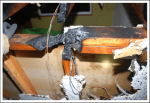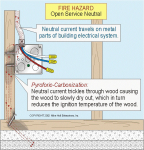mbrooke
Batteries Included
- Location
- United States
- Occupation
- Technician
Here is what put AFCIs into the code:

The above is caused by current leaking into wood members for years if not decades via an energized staple, nail, ect until the wood dries out turning into charcoal eventually igniting into a smoldering fire. Aka pyrophoric carbonization. The issue has been documented any time energized metal contacts wood. No arcing of any kind is involved.

The CMPs and many other in the electrical industry have been sold a very different etiological theory- one which is highly flawed- without any real world verification through scene investigation. UL's explanation being that over driven staples damage insulation such that a copper to copper air gap is created within the cable assembly. Repeated lightning strikes cause multi thousand volt surges (that somehow don't damage any electronic device) which arc across said gap in turn creating a carbonized path between two conductors such that 120 volts can now arc across them despite voltage dropping to normal levels. Due to the circuit's impedance or breaker's age, the OCPD does not trip instantly thus resulting in fire from the incident energy cause by this so called "high current arcing".
What people need to realize is the those presenting supporting material to the NFPA are most gifted in phenomenology, as cheesy as it may sound. Information is presented in such a manner (by the presenters) that the observer believes they have reached an objective conclusion on their own when in reality they infer what the presenter wants them to infer. No ones thoughts are their own.
How do we get this across to the rest of the trade, industry, and legal bodies?

The above is caused by current leaking into wood members for years if not decades via an energized staple, nail, ect until the wood dries out turning into charcoal eventually igniting into a smoldering fire. Aka pyrophoric carbonization. The issue has been documented any time energized metal contacts wood. No arcing of any kind is involved.

The CMPs and many other in the electrical industry have been sold a very different etiological theory- one which is highly flawed- without any real world verification through scene investigation. UL's explanation being that over driven staples damage insulation such that a copper to copper air gap is created within the cable assembly. Repeated lightning strikes cause multi thousand volt surges (that somehow don't damage any electronic device) which arc across said gap in turn creating a carbonized path between two conductors such that 120 volts can now arc across them despite voltage dropping to normal levels. Due to the circuit's impedance or breaker's age, the OCPD does not trip instantly thus resulting in fire from the incident energy cause by this so called "high current arcing".
What people need to realize is the those presenting supporting material to the NFPA are most gifted in phenomenology, as cheesy as it may sound. Information is presented in such a manner (by the presenters) that the observer believes they have reached an objective conclusion on their own when in reality they infer what the presenter wants them to infer. No ones thoughts are their own.
How do we get this across to the rest of the trade, industry, and legal bodies?


